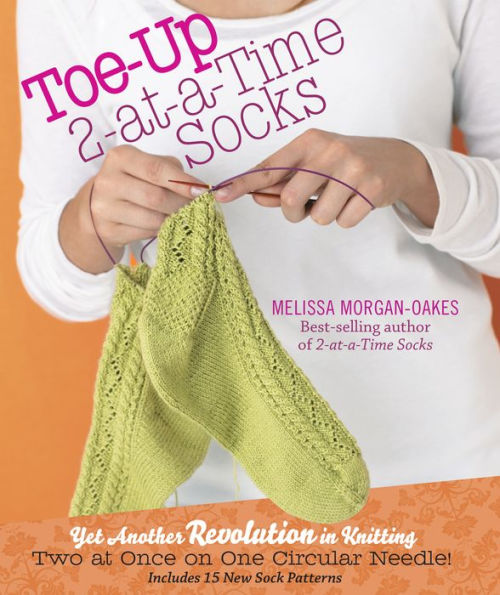Knitwear designer Melissa Morgan-Oakes revolutionized the world of sock-making with 2-at-a-Time Socks. Her ingenious approach showed delighted knitters how to simultaneously create two socks on a single circular needle. With that book, yarn enthusiasts said goodbye forever to second sock syndrome, the frustration of completing one beautiful hand-knit sock, only to remember that another must be made. Now, Morgan-Oakes turns the approach on its head or rather, its toe with Toe-Up 2-at-a-Time Socks.
Knitters adore toe-up socks for both novelty and practicality. Knitters can try on the sock as they work, they never run out of yarn before the foot is complete, and they avoid needing the dreaded kitchener stitch to finish off the toe. Many swear that toe-up socks just plain feel more comfortable, too.
Morgan-Oakes combines the pleasures of toe-up knitting with the convenience of her 2-at-a-time approach in 15 original designs for men, women, children, and babies. From the delicate and graceful ballerina sock to the kaleidoscopic, nubby peppercorn pattern, there is a style here for every pair of feet. For each pattern, Morgan-Oakes provides row-by-row instructions, charts for both large and small feet, and captivating, four-color photographs of the finished product. Readers aren’t limited to these patterns, however. Once mastered, the technique can be applied to any sock pattern.
With Toe-Up 2-at-a-Time Socks as their guide, knitters will rock the toe-up sock world, two-at-a-time, every time.
Knitwear designer Melissa Morgan-Oakes revolutionized the world of sock-making with 2-at-a-Time Socks. Her ingenious approach showed delighted knitters how to simultaneously create two socks on a single circular needle. With that book, yarn enthusiasts said goodbye forever to second sock syndrome, the frustration of completing one beautiful hand-knit sock, only to remember that another must be made. Now, Morgan-Oakes turns the approach on its head or rather, its toe with Toe-Up 2-at-a-Time Socks.
Knitters adore toe-up socks for both novelty and practicality. Knitters can try on the sock as they work, they never run out of yarn before the foot is complete, and they avoid needing the dreaded kitchener stitch to finish off the toe. Many swear that toe-up socks just plain feel more comfortable, too.
Morgan-Oakes combines the pleasures of toe-up knitting with the convenience of her 2-at-a-time approach in 15 original designs for men, women, children, and babies. From the delicate and graceful ballerina sock to the kaleidoscopic, nubby peppercorn pattern, there is a style here for every pair of feet. For each pattern, Morgan-Oakes provides row-by-row instructions, charts for both large and small feet, and captivating, four-color photographs of the finished product. Readers aren’t limited to these patterns, however. Once mastered, the technique can be applied to any sock pattern.
With Toe-Up 2-at-a-Time Socks as their guide, knitters will rock the toe-up sock world, two-at-a-time, every time.

Toe-Up 2-at-a-Time Socks
176
Toe-Up 2-at-a-Time Socks
176Related collections and offers

Product Details
| ISBN-13: | 9781603425339 |
|---|---|
| Publisher: | Storey Books |
| Publication date: | 05/07/2010 |
| Pages: | 176 |
| Sales rank: | 102,002 |
| Product dimensions: | 7.50(w) x 9.10(h) x 0.70(d) |
About the Author
Customer Reviews
Explore More Items
The key to a polished, perfect project lies in using the right increase or decrease technique to shape your knitting. Increase, Decrease is a comprehensive guide to 99 different methods for
Thirty-eight million Americans knit, and that number grows every day. The baby hat is the
Discover the perfect beginning and ending for every knitting project! Detailed instructions for each technique are combined with step-by-step photography to help you create edges that are tighter,
Now you can knit SOCKS on the straight needles you love! Alice Curtis developed the technique, and inGet Your Socks on Straightshe explains exactly how to do it. She also includes 15 original
Knitting one sock is fun and rewarding, but finishing its partner can become a chore that leaves well-intentioned knitters suffering from “second sock syndrome.” With this two-at-a-time
